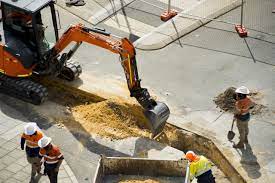Excavation constitutes a fundamental construction process wherein earth, soil, rock, or other materials are extracted from a specific location to generate space for diverse objectives. From building foundations to mining operations, excavation plays a crucial role in shaping the landscape for human needs. There are numerous types of excavation work, each tailored to specific requirements and challenges. We will delve into some of the most common types of excavation and their applications.
Trench Excavation:
Trench excavation involves digging long, narrow channels in the ground. These trenches are typically deeper than they are wide and serve various purposes. One significant application involves the installation of utility lines, like pipelines, cables, or sewer systems. Trenches are also essential for laying the groundwork for building foundations and footings. Careful planning and precise measurements are crucial in trench excavation to ensure the safety and stability of the structures to be place within.
Basement Excavation:
In densely populated urban areas, where horizontal space is limit, basement excavation provides a solution for creating additional living or storage space. It involves excavating the ground below the ground level to form underground floors for buildings. Basement excavations require intricate engineering and shoring techniques to prevent collapse and water seepage, as they involve working below the water table in many cases.
Road and Highway Excavation:
Before constructing roads and highways, extensive earthwork is performed to prepare the terrain for the roadbed. This type of excavation involves removing large volumes of soil, rock, and other materials to level the ground and remove obstacles. Proper compaction of the subgrade is essential to ensure the road’s stability and longevity.
Dredging:
Dredging is an excavation process that takes place underwater. It involves removing sediments, rocks, and other materials from the bottom of water bodies like lakes, rivers, and seas. Dredging is employ to deepen waterways, improve navigation, and maintain ports and harbors. Additionally, it is utilize in environmental restoration projects and to recover valuable minerals from underwater locations.
Cofferdam Excavation:
Cofferdams are temporary structures built to keep water out of an excavation site. This allows construction work to take place in a dry environment. Cofferdam excavation is often required for projects involving bridge piers, dam construction, or when laying the foundations for structures near water bodies. The process involves dewatering the cofferdam area and excavating the site within the confines of the structure.
Rock Excavation:
In areas with significant rock formations, rock excavation becomes a necessary process. This type of excavation involves the removal of solid rock to create space for construction or mining purposes. Rock excavation requires specialized equipment, such as rock breakers and explosives, to fracture and remove the rock safely and efficiently.
Cut and Fill Excavation:
Cut and fill excavation is a versatile technique use to level uneven terrain and create a flat surface for construction. It involves cutting soil or rock from higher elevations and using it to fill lower areas. This method is commonly use in road construction, building pads, and landscaping projects. Proper compaction and slope stabilization are critical to prevent soil erosion and settlement issues.
Borrow Excavation:
Borrow excavation is a process use when a construction project requires more earth or materials that are available on-site. In such cases, material is excavate from nearby locations, known as borrow pits, and transported to the construction site. Care must be taken to comply with local regulations and restore borrow areas responsibly after excavation.
Underground Excavation:
Underground excavation involves creating tunnels, mines, or other underground structures for various purposes. Tunnels serve various purposes, including transportation such as roads and railways, along with utility installations like water supply and sewage systems. Mining operations utilize underground excavation to extract valuable minerals and resources from beneath the Earth’s surface.
Channel Excavation:
Channel excavation focuses on creating or modifying waterways, drainage channels, and irrigation canals. This type of excavation ensures proper water flow and management, preventing flooding and facilitating agricultural irrigation. Channel excavation may involve altering the natural course of rivers or streams to improve their efficiency and prevent erosion.
Cavity Excavation:
Cavity excavation involves creating hollow spaces or voids in the ground, often for utility installations, storage purposes, or specialized construction projects. Caves, tunnels, and underground storage facilities are examples of cavity excavations. Excavation work
In conclusion,
Excavation work encompasses a wide range of techniques and applications. From foundational trenching to intricate tunneling, each type of excavation requires careful planning, skilled operators, and adherence to safety standards. The successful execution of excavation projects is essential for building infrastructure, extracting resources, and shaping the world we live in.


